
Volume 17 - Spring 2004
Binding the Booker
by Angela James
This article was first published in the October 2003 edition of the 'Antiquarian Book Review' www.rarebookreview.com and is reprinted here with their kind permission.
Authors aren't the only ones to get dressed up for the Man Booker Prize night. Books, too, put on their finery.
The typical response to a fine binding falls into one of two camps: those who ask: "Why would you bother?" and those who respond to the binder's interpretation of the book and who feel that the binding enhances it.
So, why do we bother and why the Booker? Because those of us who undertake this kind of work do so for two main reasons - we like the books per se and we like interpreting and designing and combining artistic endeavour with skilled craftsmanship - what has neatly been defined as 'head, heart and hand'.
And why the Booker? Because we were asked.
Let me explain some of the background. 'We' are the Fellows of Designer Bookbinders; the principal society in Britain devoted to the art and craft of the handbound book. There are some twenty practising Fellows who undertake commissions for private collectors, organisations and libraries and produce their own work for exhibitions both at home and overseas and some teach. In 1991, the Booker Prize committee approached Designer Bookbinders to ask if six Fellows would be interested in taking on a commission, each to bind one of the six short-listed novels. Six binders expressed a willingness to take up the challenge and having had no prior knowledge of the shortlist, were required to read, design and bind a copy of their allocated book, complete with a protective container, in the five weeks (sometimes four) between the announcement of the shortlist and the final winner at the Booker Prize Dinner. Many binders find that they cannot work to such a tight deadline but enough of us find the buzz from that kind of concentrated work becomes quite addictive and acts as a spur to creativity.
Speaking personally, I have been involved with the Booker bindings since the start in 1991 and have bound six of the shortlisted titles over the last twelve years. Each one has been very different, ranging from Ben Okri to Pat Barker, Arundhati Roy to Carol Shields, Trezza Azzopardi to Sarah Waters and each author's work has offered the opportunity for very different responses in the binding designs. I have enjoyed the intensity of the work, the thrill of the chase when tracking down a tiny fossil, an old photograph of the Cardiff dock area, a pair of white kid gloves or an image of a particular moth. I have enjoyed, too, the background research and the wider understanding that has given me. Julian Thomas, who bound Breakfast on Pluto by Patrick McCabe felt he was getting odd looks from passers-by as he rummaged through boxes at Machynlleth street market looking for lace edging and off-cuts for something 'suitably feminine' with which to emboss the gilded leather for one of the onlays.
Even the frustration of not always receiving the books, or better still the uncut folded sheets, from the publisher until a few days before adds to the frisson, although I will admit that the lateness of their arrival can badly affect what one is able to do in the severely limited time. Many publishers cannot understand the urgency. In the commercial world it takes only a matter of hours to bind a book. Not if it is handbound - more like 100 plus hours.
Six books, six binders and six very varied bindings at the end of it. Bindings of goatskin, calf, vellum, wood, paper. Traditional structures, exposed sewing, unusual artefacts - all are used to express the binder's ideas.
The ideal combination is obviously to try to pair the binder with a book which has a strong appeal for him/her, not always easy, but it does happen and the results are then more satisfying for the artist and probably more so for the recipient too. Faith Shannon speaks of having the author very much in mind when binding the Booker and not trying to make a 'great I AM' binding. Her three Bookers: Scar Tissue by Michael Ignatieff; Grace Notes by Bernard MacLaverty; Fasting Feasting by Anita Desai, called on her experiences of her father's death, her childhood in Belfast and her very early years in India, eliciting very different responses to each book. All of those who have been involved over the past 12 years have had their favourites and feel particularly attached to them. Jenni Grey, who has bound several Bookers, probably sums it up for all of us when she lists the best things about the Booker binding commissions: the opportunity to just sit down and read for hours on end without feeling guilty about everything else that you ought to be doing; reading authors and work that you might not normally have selected; being given more scope for experiment than other commissions when the commissioner tends to want something along the lines of a binding they have seen before; and the fact that the tight deadline makes you think and work differently which can be not only stimulating but can also feed into your other work.
So what do these bindings do for the books? To start with, if we receive uncut sheets we have folds and the sections can be properly sewn. Very few hard-backs are sewn now and are really no better than paperbacks with a hard case. The structure of a handbound book and the sound materials used mean that the binding should last for decades if not centuries. The quality of the paper used for printing often leaves too much to be desired and almost always the grain direction is wrong. These are things beyond the binder's control but the quality of the binding should be a high priority. The feel of a well bound book in the hands is something which many people value, added to which there is the smell of the leather (if used) and the joy to the eye of a piece of fine craftsmanship - three senses involved - which helps to explain why we do it. One criticism of design bindings is that they cannot be handled or read and although this may sometimes be true of bindings with very tight joints and the thinnest of leather, I would say that all the Booker bindings can most certainly be picked up, opened and read - not perhaps the sort of book you would take to bed and read but very much something you can enjoy and take care of. Not just a book to be slotted onto a bookshelf but an object to be displayed and appreciated.
What do the authors make of what we have made of their work? That question is often not answered. It is not always possible to meet one's author at the noisy crowded Booker Dinner (where the bindings are displayed prior to presentation). Often there is no feedback at all, which leaves the binder in ignorance of the reaction - perhaps that is sometimes just as well. I do not suppose all authors like what we have done with their books, or are even interested. Some probably fall into the 'Why would you bother?' category, but there have been many occasions when author and binder have met and the response has been one of surprise, interest and appreciation. I have been the recipient of two or three letters of thanks from 'my' authors and in 1991 when I bound The Famished Road by Ben Okri, which won the Prize that year, I met the author before the dinner and showed him the binding. He asked what would happen to it and I told him it would be presented to him during the course of the evening, to which he replied: 'I should have written a better book.' What higher praise could a binder ask for?
To date, Fellows of Designer Bookbinders have bound 71 books for the Booker Prize (only five books were shortlisted one year) and it is an association which I hope will continue for many years to come. In 2002, the sponsorship of the prize was taken on by the Man Group plc and it has become the Man Booker Prize, with increased prize money for both the outright winner and the other five authors.
I hope the addition of a fine binding on their work gives them as much pleasure as it gives those of us who make them. Long after their moment of glory and long after the prize money has been spent, perhaps the fine-binding on their book will become their most valued reward.
|
The
2003 Shortlisted Booker Bindings
|
|
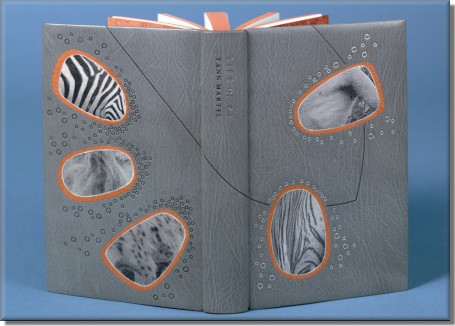 |
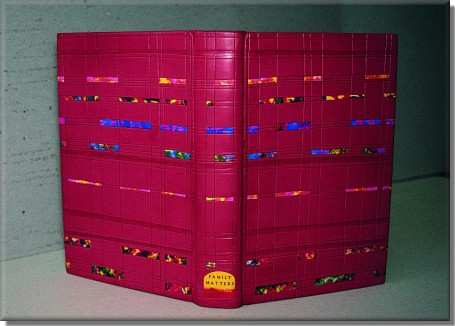 |
|
Life of Pi
by Yann Martel
|
Family
Matters by Rohinton Mistry
bound By Lester Capon |
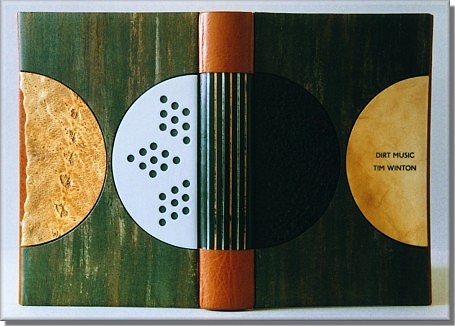 |
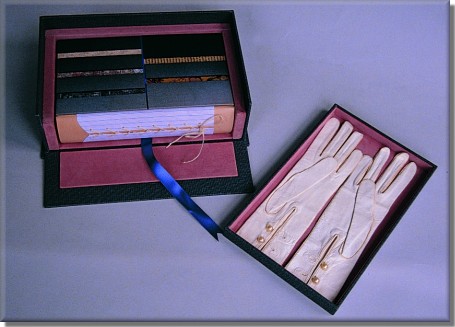 |
|
Dirt Music
by Tim Winton
|
Fingersmith
by Sarah Waters
bound by Angela James |
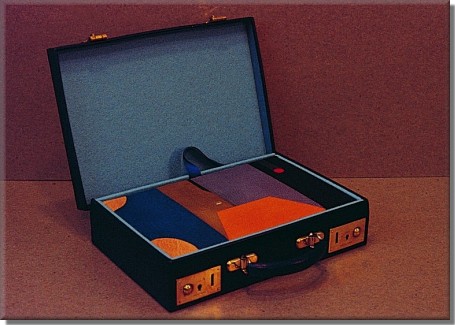 |
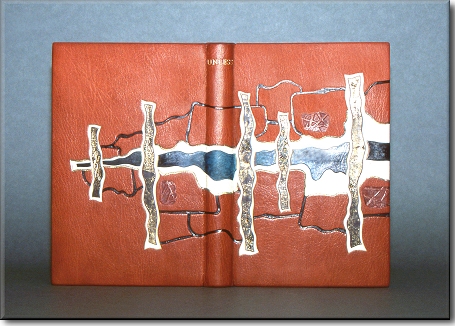 |
| The
Story of Lucy Gault by William Trevor bound by Peter R. Jones |
Unless
by Carol Shields
bound by Julian Thomas |
Angela James - Angela has been a Fellow of Designer Bookbinders since 1975 and was President from 1990-96. After taking a degree in Textile Design with bookbinding as a subsidiary subject at Glasgow School of Art, she went on to work at the Cockerell Bindery, later joining James Brockman in setting up the Eddington Bindery. She set up her own bindery in 1977. Angela organises the bindings of the six short listed novels for the annual Man Booker Prize.
